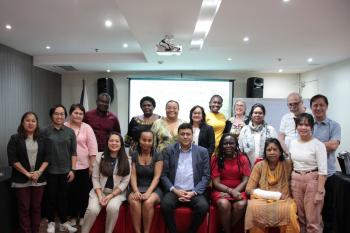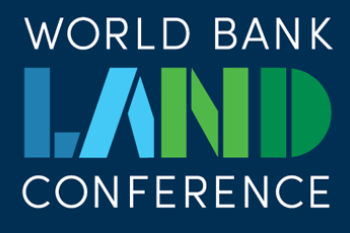Integrating STDM into Customary Land Administration Processes - the case of Mungule Chiefdom in Zambia’s Chibombo District
The Global Land Tool Network has been actively present in Zambia since 2014 where it has been implementing the Social Tenure Domain Model (STDM) at country level, and these interventions have been implemented in Mungule Chiefdom in Zambia’s Chibombo District. STDM implementation encompasses the wide range of GLTN land tools such as Participatory Enumerations, the Continuum of Land Rights approach, the Gender Evaluation Criteria, Pro-poor Land Recordation and Land Governance among others.
Located in the periphery of Lusaka City, Mungule Chiefdom is under pressure for land and natural resource exploitation from the expanding capital of Zambia. The Huairou Commission, a GLTN partner, with the support of its affiliate organizations namely the People’s Process on Hosing and Poverty in Zambia/Zambia Homeless and Poor Peoples Federation (PPHPZ/ZHPPF) and Katuba Women Association (KWA), supported grassroots women to implement STDM in Mungule Chiefdom. The first phase of the project, implemented between June and December 2014, focused on mobilizing and raising the awareness of the community and key stakeholders about STDM and its usefulness to the Mungule Chiefdom.
The second phase of this GLTN intervention that started in September 2015 seeks to integrate STDM into customary land administration and respond to gender issues in Mungule Chiefdom. The ultimate goal of this initiative is to issue customary certificates of occupancy to residents in the area. A unique feature for the Zambian situation is that is that STDM is being implemented in rural/customary tenure contexts where gender issues demand special attention. Enumeration surveys and mapping were completed in 7 villages: Meleki, Mungule, Mutakwa, Chilete, Mukumbwanyama, Mankalu and Kandeke. The enumeration covered 308 households with a total of 1 731 residents
A major win for this GLTN intervention in Mungule Chiefdom has been the establishment of local institutions that are now facilitating the implementation of STDM at the community level. Comprised of headmen, headwomen and the councilor for the local ward, the Mungule Technical Advisory Team (MTAT) is tasked with disseminating information on STDM and mobilizing political support to facilitate its implementation. The STDM Steering Committee now works with this locally based MTAT. The Senior Headman, who oversees the work of six other traditional leaders, has embraced the STDM idea so much that it has now become a regular subject of discussion at their meetings. The STDM Steering Committee also holds regular village meetings in which the local community is given updates on the status of the certification process, clarifies areas of concern as raised by the community while reassuring them that they would ultimately be issued with their certificates of occupation.
Another win in implementing GLTN tools in Zambia has been the creation of new partnerships and an increased interest from, and engagement of State Authorities. Slum/Shack Dwellers International (SDI), a GLTN partner, has local affiliates PPHPZ and ZHPPF who have provided technical support for project implementation. Katuba Women’s Association has also supported partnerships by bridging the gap between the local communities and key state partners. The key government partners in the initiative are the Ministry of Lands, the Surveyor General’s office, the Ministry of Local Governments and the Chibombo District Counsel and Planning Office. The Surveyor General’s office frequently officiates at STDM functions and this provides the much needed government recognition, endorsement and support for GLTN tools.
From the STDM interventions carried out so far, some emerging impacts are already being observed in Mungule Chiefdom. The residents and Indunas have noted that the work being done in Mungule is important because it will in due course reduce boundary conflicts that result in displacement and violence, particularly of women and widows. Through STDM and the process of demarcating and documenting land occupations, boundaries and land rights have been identified, recorded and validated by the beneficiary communities. Through the mapping and the agreements that are made on land rights and boundaries, it is now possible for the residents in the communities to do their own planning around the communal resources, rather than having the planning done for them. This will now provide an avenue for the Chibombo District Council to directly engage in the planning for the development of Mungule. The plans and standards developed will particularly help to rein in tree loggers, sand harvesters and quarry stone miners as these extractive industries in Mungule have erstwhile been largely unregulated and unscrupulous in their operations.
This GLTN initiative is also set to improve the quality of life for the residents of Mungule through increased security of tenure. With the imminent expansion of Lusaka City and the subsequent conversion of customary to urban land, the residents of Mungule Chiefdom are now being prepared to engage with such urban processes and have already shown their readiness to jointly articulate a vision of what development should look like in their area.
The implementation of STDM in Mungule has also now made it possible to clearly articulate and capture the social tenure relations of all community members, including the often excluded polygamous relations which are the norm in Africa. The mai nini (subsequent wives and their children) can now have their names appearing on the certificates and on registries as having various tenure relations to respective parcels of land. The STDM intervention has thus highlighted the land tenure rights of those groups normally discriminated against by traditional land registration processes.
The implementation of STDM in Mungule comes at a time when the Government of Zambia is also implementing its National Land Titling Program. While commending the work started by grassroots women at the launch of the certificate of occupancy, the Surveyor General’s office has described the STDM interventions as ‘real, pro-poor, low-cost approaches that are scalable and needed by people in rural communities.’ STDM has received a further confidence boost from the Surveyor General’s office who have applauded the grassroots mapping and enumeration and explained the ongoing efforts to change the overly strict laws that govern land surveying in Zambia. The National Land Titling Program, a national effort to provide titles to the entire country, outlines that these laws will be relaxed in rural areas and that work was already in progress. With a commitment to continue the engagement with STDM, the Surveyor General’s office directed the District Planning Commission to validate the work already done in Mungule.
Further support for STDM has also been received from the Surveyors’ Institute of Zambia who have offered to verify and validate the mapping done, with proposals of funding this exercise through the National Land Titling Program. With all stakeholders being on board as is the case now, the STDM implementation in Zambia will be sustainable in the long run, even with discussions being held on up scaling of the GLTN interventions. A significant gain for the initiative is the linkage between the STDM pilot and the National Land Titling Program.


